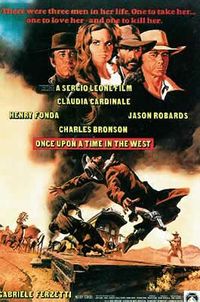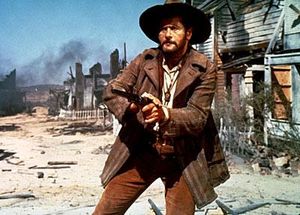 Movie poster for Once Upon a Time in the West
Movie poster for Once Upon a Time in the West
Spaghetti Westerns is a nickname for a broad sub-genre of Western film that emerged in the mid-1960s, so named because most of them were produced by Italian studios. Originally they had in common the Italian language, low budgets, and a recognizable highly fluid, violent, minimalist cinematography that eschewed (some said "demythologized") many of the conventions of earlier Westerns—partly intentionally, partly as a result of the work being done in a different cultural background and with limited funds. The term was originally used disparagingly, but by the 1980s many of these films came to be held in high regard, particularly because it was hard to ignore the influence they had in redefining the entire idea of a western up to that point.
The best-known and perhaps archetypal spaghetti Westerns were the so-called Man With No Name trilogy (or Dollars Trilogy) directed by Sergio Leone, starring the American TV actor Clint Eastwood and with musical scores composed by Ennio Morricone (all of whom are now synonymous with the genre): A Fistful of Dollars (1964), For a Few Dollars More (1965), and The Good, the Bad and the Ugly (1966). The last is one of the most famed Westerns of all time (although, atypically for the genre, it had a relatively high budget in excess of one million USD).
Many of the films were shot in the Spanish desert region of Almería, which greatly resembles the landscape of the American Southwest. (A few were shot in Sardinia.) Because of the desert setting and the readily available southern Spanish extras, a usual theme in Spaghetti Westerns is the Mexican Revolution, Mexican bandits and the border zone between Mexico and the USA.
Spaghetti westerns are known as "macaroni westerns" in Japan.
 Eli Wallach in The Good, the Bad and the Ugly, a
Spaghetti Western
Eli Wallach in The Good, the Bad and the Ugly, a
Spaghetti Western
Contents |
Other "Food Westerns"
The name led to various other non-US westerns being associated with food and drink.
Sometimes the names chorizo/paella Western are used for similar films financed by Spanish capital, although Leone's earlier films were actually shot in Andalucia. Publicity for the Japanese comedy film Tampopo coined the phrase "Noodle Western" to describe the parody made about a noodle restaurant. Robert Rodriguez's Westerns have been called "Burrito Westerns." Sometimes Hrafn Gunnlaugsson's Viking movies are called "Cod Westerns". The German Westerns of the 1960s, which were successful in Europe before the Italian Westerns, were made after novels by Karl May and mostly filmed in former Yugoslavia. German Westerns are often called "Kraut Western". The Red Dwarf episode Gunmen Of The Apocalypse has been described as the world's only "Roast Beef Western". John Woo's Western movies were described by Roger Ebert as Dim Sum Western. The "Red Western" or "Ostern" is the Soviet and eastern bloc's take on the genre. (Time magazine dubbed the animated TV series Samurai Jack, which combined elements of — among others — anime and the Sergio Leone films, a "sashimi Western.")
External links
- The Spaghetti Western Database
- 10,000 Ways to Die Book about Spaghetti Westerns from 1963-1973, released under a Creative Commons license
- SpaghettiWesterns.com.ar Site argentinian
- Spaghetti-Western.org Site spanish
References
Weisser, Thomas.Spaghetti Westerns: the Good, the Bad and the Violent - 558 Eurowetsrens and Their Personnel, 1961-1977.Jefferson, N.C., McFarland, 1992.
Categories: Film genres




 216.73.216.81
216.73.216.81 User Stats:
User Stats:
 Today: 0
Today: 0 Yesterday: 0
Yesterday: 0 This Month: 0
This Month: 0 This Year: 0
This Year: 0 Total Users: 117
Total Users: 117 New Members:
New Members:
 216.73.xxx.xx
216.73.xxx.xx
 Server Time:
Server Time: